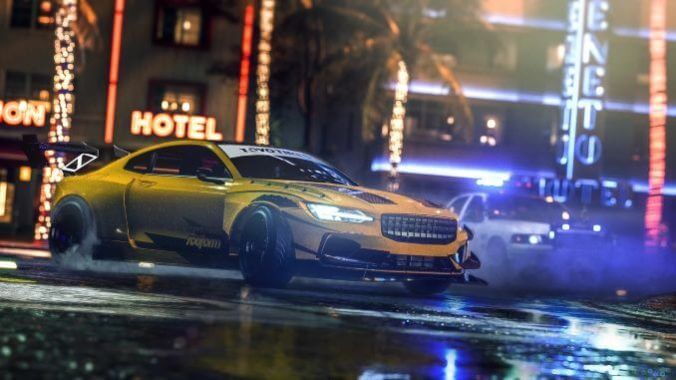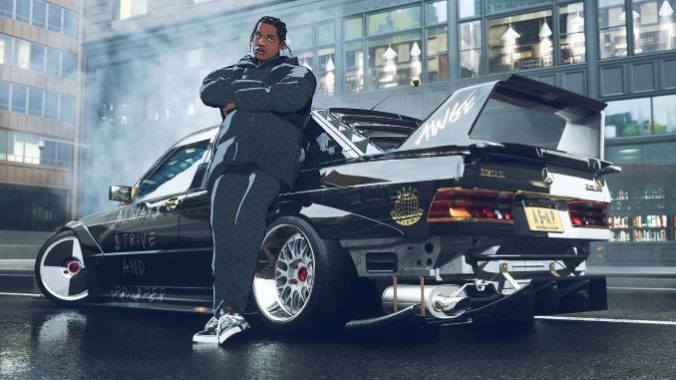According to my Xbox I’ve logged 35 hours in Need for Speed Unbound. I think that’s a glitch caused by the Quick Resume feature, but even at between 15 and 20 hours, it gave me a lot to think about. When I fired up Need for Speed Unbound, 2005’s Need for Speed: Most Wanted immediately came to mind. Like Unbound, Most Wanted was built around street racing and car chases, though with a greater emphasis on doling out retribution to your pursuers. Most Wanted was the first in the series to combine the Fast and Furious-style tuner-racer influence of the Underground brand of Need for Speed with the police chases of Need for Speed: Hot Pursuit. Underground 2 had an open world, and so did Most Wanted and its narrative sequel Need for Speed: Carbon. Over the next several years, the Need for Speed games would variously hew to their street racing roots or try more closed-track style racing, and alternate between being story-based and avoiding narratives. Developer Criterion Games, who was making the Burnout series of racing games (which didn’t license real life cars and were increasingly based around high-velocity crashes) at the time, culminating in 2008’s Burnout Paradise, would go on to make new games called Need for Speed: Hot Pursuit and Most Wanted in 2010 and 2012. After a few years off to assist on the Battlefield and Star Wars: Battlefront games, they’ve returned to racing, picking up from the now-dissolved Ghost Games, who rebooted Need for Speed in 2015.
Lacking familiarity with most of those games, I was jumping in here grasping at decade-old references, and it was fun (and useful) to use EA Play through Game Pass to briefly dabble with the steps the franchise has taken since then to reorient myself. Big takeaways: in 2015 (where they approximate L.A.), they were still using FMV like in 2005, featuring Faye Marsay of Game of Thrones and Andor, and assuming players are male and assigning the protagonist accordingly; in 2017 (set in and around an area based off of Las Vegas) you’re primarily a guy, but he comes from a crew that includes a woman that you sometimes switch to, channeling action heist movies; in 2019 (set in a large map based off of Miami) they begin to (re?)introduce a theme of overeager police (the intro cinematic sees a police officer talked out of killing a street racer by another police officer pointing out they’re on camera) while also allowing the player to choose an avatar, including multiple genders.
Need for Speed: Unbound is pulling on a lot of these connected threads. For instance, in-game radio ads frequently emphasize a tough-on-crime mayor funneling resources toward the police department to stop street racing. And, as players drive through the city delivering their fellow racers—whose avatars they see in the regular matches—to safehouses they can later use, occasionally conversation will drift toward the mayor and her crusade. Of course, any sort of broader societal critique falls flat when you are in fact pushing double digits in developed commercial and residential districts or flying through opposing traffic and tearing up guardrails. Besides the game’s problem with signposting which objects are easy to drive through and which will stop you, complaints about police overreach are undercut by driving in a way that would kill people in real life. But if a player’s heat level is low enough, police won’t even know them. The ability to drive 60 mph in opposing traffic in front of a cop, in addition to being able to speed by police without them hitting the sirens and, separately but distinctly, the fact the traffic lights don’t work, contribute to feeling like this is very much a clockwork world.
In Unbound—unlike the original Most Wanted—players’ wanted levels reset every day, as if the police’s minds reset every 24 hours. Unlike in that older game, players don’t need to change their car’s look or switch cars for a while to make the heat go down. The short memory of the patrolling police basically turns each adventure out into the streets turns into a wager where you have to weigh the amount of money you might make against how much you’ll stand to lose if the police takes it all. At least money and race restarts reset between day and night sessions. The combination of challenging computer-controlled racers and the high buy-ins for the races that propel the narrative forward create a difficult game-within-the-game. It’s also surprisingly forgiving in that if you fail the three-level qualifier race on a Saturday, you get sent back to Friday to earn more money. There’s no narrative reason for this winking bit of time travel, but it suits the game.
Similarly flirting between weighty reality and fantasy, the cartoon-inspired art style highlights the game’s photorealistic cars and environments through cel-shaded characters and driving effects. At first it made me think about the annoying impact comic book culture has had on mass media, but the aesthetic quickly grew on me. It makes everything feel light and fun, especially considering the narrative is based around the protagonist and her boss/surrogate father—Rydell, owner of Rydell’s Rides—being betrayed by their best friend in the prologue. Said best friend goes on to start a racing tournament, and basically ignores the protagonist when confronted at the first meet up. The slight edge and convoluted absurdity are easier to swallow when the whole deal looks and feels like a cartoon.

Customization is taken to a decently deep level with the racers, for whom players can choose outfits and hair. The currency players use to purchase these aesthetic items or to upgrade the car are won in career mode, earned-in game, and not purchased with real money. Yes, there are special editions and pre-order bonuses that can help in certain game modes, but even in those modes currency for upgrading the vehicles is still earned through races. I haven’t effectively tested whether equipping your driver with a “Lakeshore Police Department” t-shirt leads to smoother or more relaxing car chases. In fact, the character customization probably matters more online—my first notable remark in the career was realizing the character was wearing the same clothes two years after the prologue. That dog don’t hunt, but no one’s coming to Need for Speed: Unbound for flawless continuity.
Whether you last played a Need for Speed game 10 or 15 years ago or are new to the series, you’re likely here for the cars. Some of the most fun I had was adapting a piece of art to my 1999 Mitsubishi Eclipse’s body, going through the decals to see if they still had SPARCO and discovering that myriad pride flags join the many nations whose colors you can rep on your ride. The level of depth to what players can change about how cars look, sound, and feel is impressive. Besides tiered (basic, sport, pro, super, elite) car parts unlocked by upgrading the garage and purchased with the just rewards of some righteous racing, some components have extra levels of choice and design. Suspension has standard, road, and off-road versions on each level; tires have those, plus drift and grip. These, in addition to the several types of turbos and superchargers players can add to their cars, deepen the amount of thought that goes into customization—do you want speed on the high end or low? What sort of differential best suits your driving style? Players can’t change where the car gets its power (you’re stuck with their default AWD, RWD, or FWD) but can customize what kinds of races and chases it’s built for. Some races have off-road sections that player choices will put them at an advantage or disadvantage for. In fact, because every starter car is “B” tier and getting through the qualifier requires one each of “A,” “A+,” “S,” and “S+” cars, players will find themselves putting together a stable of options. Plan wisely, act accordingly. I couldn’t help but think of a Pokémon team—you might want to just focus on leveling up your starter, but being a champion is going to require you to develop different specialties and learn how to move between them. The gameplay is generally effective and surprisingly challenging even though it’s not quite “simulation” racing. And while the streets are sparsely populated, a more realistic depiction of American urban transit wouldn’t be as fun to navigate through.
Unbound could do more as far as onboarding goes, but perhaps that’s why you get mulligans with the qualifier challenges. Practice makes perfect after all, and it’s definitely a game that expects you to try to get good at it. Difficulty now controls the amount of times players can reset races out in the world, in addition to the competitiveness of computer-controlled racers and the aggressiveness of police. It’s another resource to manage.
One head scratcher for me is the addition of A$AP Rocky. It’s not as distracting as Keanu Reeves in Cyberpunk 2077, but the comparative lack of narrative centrality makes his inclusion feels even less necessary. Now, hearing “Palace” in the game intro cinematic did make me smile—Live.Love.A$AP was one of my favorite mixtapes in 2011—but not only do none of the other tracks from the tape make it (where, pray tell, is “Everything is Purple?”), Rocky probably recorded three or four lines for the whole game. There’s one other song he features on, on a relatively listenable soundtrack with too little rock music but a decent variety of hip hop and electronic styles that inevitably gets repetitive. Whenever I win a takeover race—the only time he shows up—he delivers one of two enthusiastic but perfunctory congratulations.
Overall, Criterion’s return to Need for Speed is solid, even remarkable in small ways, but not an overwhelming success. The new art style takes some of the heat off the cheesy storyline. It’s fun to look at and decent to drive, though it could definitely use a little more of an on-ramp. Repetitiveness is a common problem in this game, as players will find themselves offered the same tracks to race on. But it’s a matter of what areas of the city one races in, rather than a complete lack of variety. It’s a component of the open-world, choose-your-own adventure, wagering your time and money aspect of the game. Still, its entire construction floats between wanting to be narrative-driven and wanting to be the unmoored, competition-first racing game that the online competitive mode is. It’s a satisfactory racing situation, and a clear and intentional step in the right direction after the middling reception which met the last few games. Still, it’s a little ways off yet from being a transcendent racing experience. There’s no split-screen competitive mode, there’s no just sitting and customizing cars outside of career mode, and there’s only the one career mode file. Accessibility options don’t include button mapping, though that can be done from the Xbox itself. It’s a step in the right direction, narratively and visually more interesting than Need for Speed has often been in the past, and a satisfactory if not mind-blowing driving experience.
Need for Speed Unbound was developed by Criterion Games and published by EA. Our review is based on the Xbox Series X|S version. It’s also available for the PlayStation 5 and PC.
Kevin Fox, Jr. is a freelance writer, editor, and critic. He is a former Paste intern with an MA in history, who loves videogames, film, TV, and sports, and dreams of liberation. He can be found on Twitter @kevinfoxjr.

